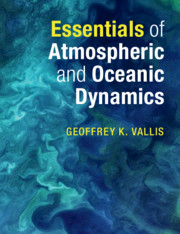87 results
2 - Terrestrial Atmospheres
-
-
- Book:
- Zonal Jets
- Published online:
- 26 February 2019
- Print publication:
- 28 February 2019, pp 9-45
-
- Chapter
- Export citation
15 - Overturning Circulation and the Thermocline
- from Part III - Oceans
-
- Book:
- Essentials of Atmospheric and Oceanic Dynamics
- Published online:
- 21 March 2019
- Print publication:
- 24 January 2019, pp 305-323
-
- Chapter
- Export citation
1 - Fluid Fundamentals
- from Part I - Geophysical Fluids
-
- Book:
- Essentials of Atmospheric and Oceanic Dynamics
- Published online:
- 21 March 2019
- Print publication:
- 24 January 2019, pp 3-23
-
- Chapter
- Export citation
Part II - Atmospheres
-
- Book:
- Essentials of Atmospheric and Oceanic Dynamics
- Published online:
- 21 March 2019
- Print publication:
- 24 January 2019, pp 213-214
-
- Chapter
- Export citation
9 - Waves and Mean-Flows
- from Part I - Geophysical Fluids
-
- Book:
- Essentials of Atmospheric and Oceanic Dynamics
- Published online:
- 21 March 2019
- Print publication:
- 24 January 2019, pp 170-187
-
- Chapter
- Export citation
Bibliography
-
- Book:
- Essentials of Atmospheric and Oceanic Dynamics
- Published online:
- 21 March 2019
- Print publication:
- 24 January 2019, pp 346-351
-
- Chapter
- Export citation
Part III - Oceans
-
- Book:
- Essentials of Atmospheric and Oceanic Dynamics
- Published online:
- 21 March 2019
- Print publication:
- 24 January 2019, pp 287-288
-
- Chapter
- Export citation
3 - Dynamics on a Rotating Planet
- from Part I - Geophysical Fluids
-
- Book:
- Essentials of Atmospheric and Oceanic Dynamics
- Published online:
- 21 March 2019
- Print publication:
- 24 January 2019, pp 47-62
-
- Chapter
- Export citation
13 - Planetary Atmospheres
- from Part II - Atmospheres
-
- Book:
- Essentials of Atmospheric and Oceanic Dynamics
- Published online:
- 21 March 2019
- Print publication:
- 24 January 2019, pp 257-286
-
- Chapter
- Export citation
5 - Geostrophic Theory
- from Part I - Geophysical Fluids
-
- Book:
- Essentials of Atmospheric and Oceanic Dynamics
- Published online:
- 21 March 2019
- Print publication:
- 24 January 2019, pp 83-103
-
- Chapter
- Export citation

Essentials of Atmospheric and Oceanic Dynamics
-
- Published online:
- 21 March 2019
- Print publication:
- 24 January 2019
-
- Textbook
- Export citation
Index
-
- Book:
- Essentials of Atmospheric and Oceanic Dynamics
- Published online:
- 21 March 2019
- Print publication:
- 24 January 2019, pp 352-356
-
- Chapter
- Export citation
Part I - Geophysical Fluids
-
- Book:
- Essentials of Atmospheric and Oceanic Dynamics
- Published online:
- 21 March 2019
- Print publication:
- 24 January 2019, pp 1-2
-
- Chapter
- Export citation
6 - Rossby Waves
- from Part I - Geophysical Fluids
-
- Book:
- Essentials of Atmospheric and Oceanic Dynamics
- Published online:
- 21 March 2019
- Print publication:
- 24 January 2019, pp 104-122
-
- Chapter
- Export citation
2 - Equations for a Rotating Planet
- from Part I - Geophysical Fluids
-
- Book:
- Essentials of Atmospheric and Oceanic Dynamics
- Published online:
- 21 March 2019
- Print publication:
- 24 January 2019, pp 24-46
-
- Chapter
- Export citation
14 - Wind-Driven Gyres
- from Part III - Oceans
-
- Book:
- Essentials of Atmospheric and Oceanic Dynamics
- Published online:
- 21 March 2019
- Print publication:
- 24 January 2019, pp 289-304
-
- Chapter
- Export citation
12 - Midlatitudes and the Stratosphere
- from Part II - Atmospheres
-
- Book:
- Essentials of Atmospheric and Oceanic Dynamics
- Published online:
- 21 March 2019
- Print publication:
- 24 January 2019, pp 237-256
-
- Chapter
- Export citation
11 - The Hadley Cell and the Tropics
- from Part II - Atmospheres
-
- Book:
- Essentials of Atmospheric and Oceanic Dynamics
- Published online:
- 21 March 2019
- Print publication:
- 24 January 2019, pp 215-236
-
- Chapter
- Export citation
8 - Instability
- from Part I - Geophysical Fluids
-
- Book:
- Essentials of Atmospheric and Oceanic Dynamics
- Published online:
- 21 March 2019
- Print publication:
- 24 January 2019, pp 144-169
-
- Chapter
- Export citation
Preface
-
- Book:
- Essentials of Atmospheric and Oceanic Dynamics
- Published online:
- 21 March 2019
- Print publication:
- 24 January 2019, pp ix-x
-
- Chapter
- Export citation



